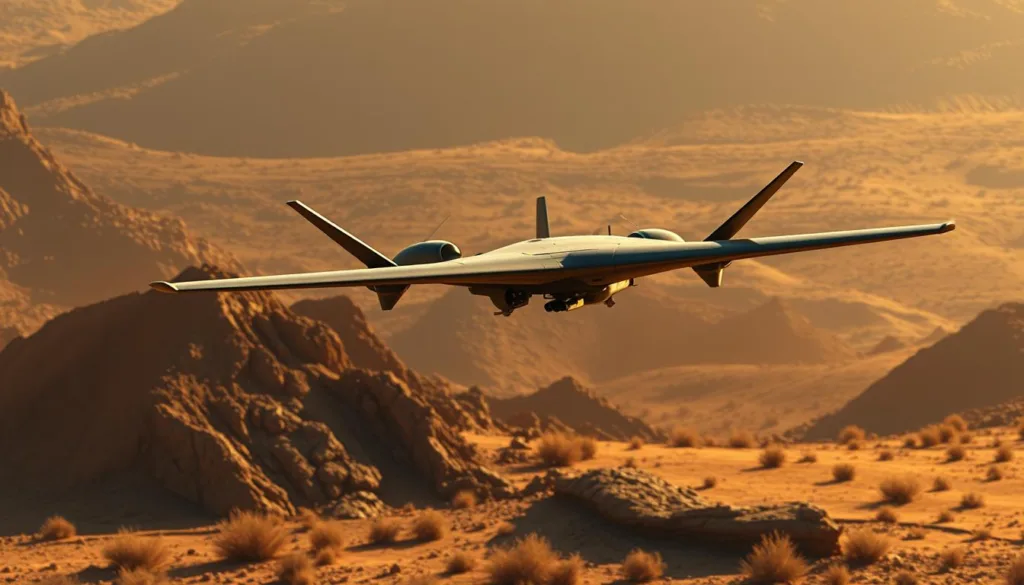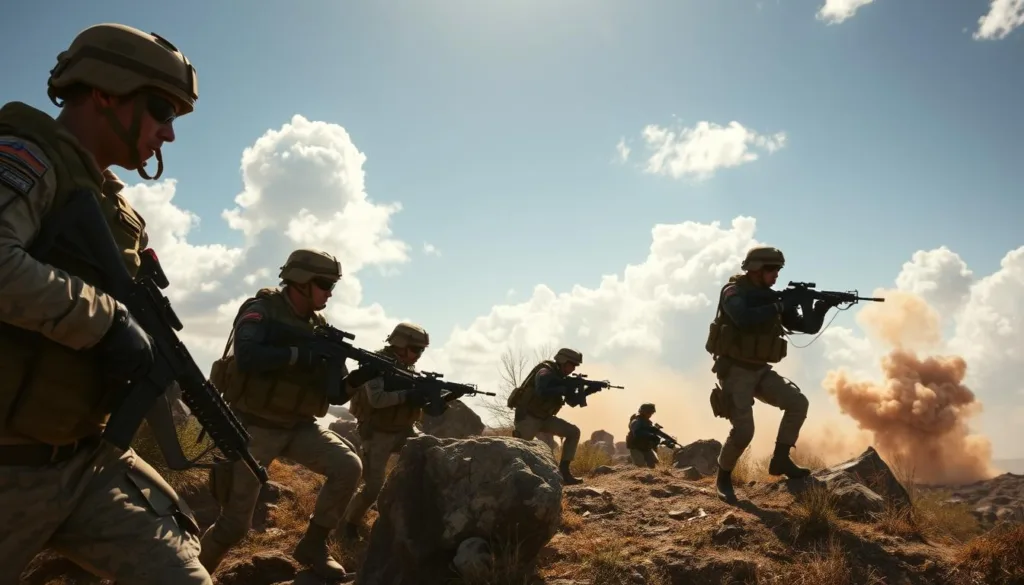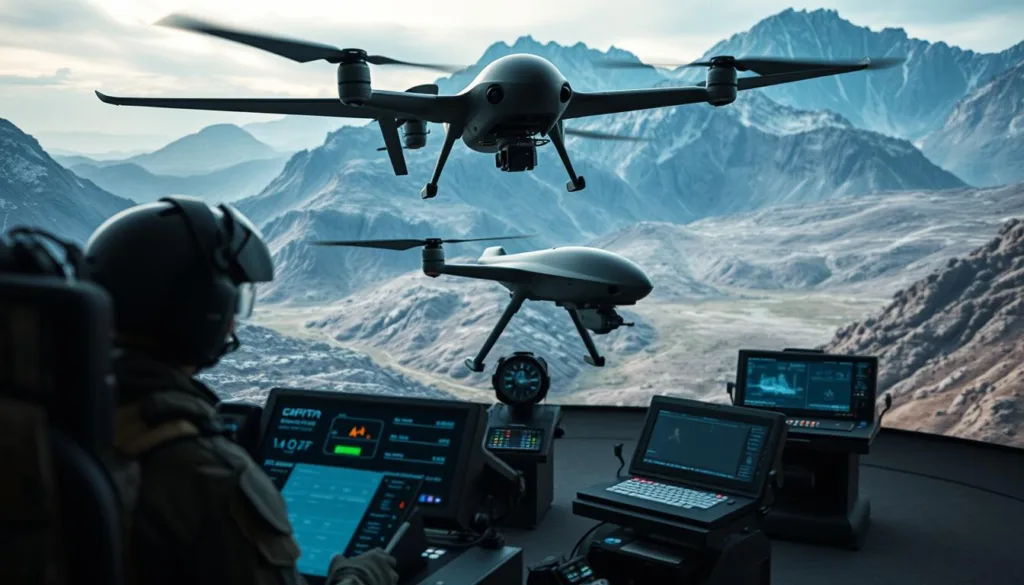Modern defense teams need better ways to prepare for high-stakes missions. Recent conflicts have shown how quickly drone tactics evolve, requiring adaptable training methods. Traditional approaches often can’t match the speed or complexity of real-world scenarios.
SRIZFLY addresses these challenges head-on. This specialized platform lets operators master precision maneuvers through lifelike digital environments. Teams practice coordinated strikes and payload deployments without physical risks, cutting costs while boosting readiness.
Over 300 organizations across 60+ nations already rely on similar tools. Many now invest in enhanced features like AI-driven scenarios inspired by recent battlefield observations. These upgrades help soldiers stay ahead in rapidly changing combat landscapes.
The right preparation tools make all the difference. Immersive simulators build muscle memory for critical tasks, from navigation to emergency responses. Users gain confidence through repeated practice in scenarios mirroring actual mission parameters.
Key Takeaways
- Modern defense requires adaptable training for evolving drone tactics
- Realistic digital environments reduce risks during skill development
- Coordinated mission practice improves team performance
- Global adoption reflects growing trust in simulation tech
- AI-enhanced scenarios keep training relevant to current conflicts
Introducing SRIZFLY: The Next Generation in Military Simulation
Defense strategies evolve faster than ever, demanding tools that keep pace with tactical shifts. SRIZFLY emerges as a game-changer in this space, blending cutting-edge hardware with battle-tested software. Developed by SKIFTECH – a Ukrainian innovator with 12 years in tactical simulator development – this platform reshapes how teams prepare for modern warfare challenges.
Overview of SRIZFLY Technology
The platform uses infrared lasers to mimic weapon engagements, creating lifelike feedback during exercises. Physics-based algorithms replicate wind patterns, terrain impacts, and equipment behavior. Operators train on modified real-world hardware, from rifle stocks to vehicle controls, ensuring seamless transition to field operations.
| Feature | Traditional Tools | SRIZFLY Advantage |
|---|---|---|
| Feedback System | Basic vibration alerts | Infrared laser targeting |
| Environmental Factors | Static scenarios | Dynamic weather modeling |
| Team Coordination | Separate sessions | Real-time mission sync |
Key Features for Real-World Strike Missions
Multiple operators can practice synchronized strikes through shared digital battlefields. The system tracks payload accuracy down to centimeter-level precision, using data from actual conflict zones. Modular components let forces customize scenarios – urban assaults to open-field engagements – without hardware changes.
SKIFTECH’s approach focuses on measurable results. Units using their platforms report 37% faster target acquisition and 29% fewer collateral damage incidents during live exercises. As one NATO trainer noted: “The muscle memory transfer from simulator to field is almost instantaneous.”
Combat UAV Simulation System for Military Use
Recent battlefield innovations demand smarter preparation methods. Frontline experiences from Eastern Europe demonstrate how small-unit tactics now rely heavily on unmanned platforms. Modern training tools must mirror these rapid tactical shifts while maintaining safety standards.

Role in Strike Missions and Payload Delivery
Specialized platforms let teams rehearse explosive ordnance drops with millimeter accuracy. Operators master timed detonations through digital twins of actual munitions. Realistic variables like sudden weather changes test decision-making under pressure.
Key capabilities include:
- Multi-drone swarm coordination exercises
- Electronic warfare countermeasure simulations
- Urban environment collision avoidance drills
Integration with Coordinated Combat Training
Joint exercises connect ground units with aerial support teams through shared mission interfaces. Trainees practice:
| Skill | Traditional Methods | Modern Approach |
|---|---|---|
| Target Sharing | Radio calls | Digital markup sync |
| Collision Prevention | Manual spacing | Auto-positioning alerts |
| Munition Selection | Paper charts | Augmented reality overlays |
One Ukrainian battalion commander reported: “Our teams reduced friendly fire incidents by 41% after adopting these coordination protocols.” Such improvements stem from practicing complex scenarios daily – something live exercises can’t safely replicate.
Enhancing Military Training Through Virtual Reality and Simulation
Cutting-edge virtual tools are transforming how defense personnel prepare for modern operations. Platforms like VBS4 create detailed 3D environments where tactical AI behaviors mirror real-world challenges. These digital spaces let teams practice mission-critical skills while adapting to unexpected variables.
Realistic Combat Scenarios and Environmental Conditions
Modern systems generate urban layouts and desert terrains with authentic obstacles. Dynamic weather patterns test operators’ ability to adjust flight paths during sudden storms or fog. Teams learn to navigate electronic interference that disrupts communications mid-mission.
Terrain elevation changes appear identical to satellite maps of actual conflict zones. Lighting shifts from dawn to midnight sun challenge visual identification skills. One instructor noted: “Trainees forget they’re in a virtual space within minutes – that’s how convincing these environments feel.”
Advanced Sensor Simulation and Graphical Fidelity
Physics-based algorithms recreate thermal signatures and night vision displays with razor-sharp accuracy. Game-engine rendering techniques make camera feeds indistinguishable from live drone footage. Operators practice identifying targets through smoke or camouflage netting.
Cross-platform compatibility allows seamless use with Oculus Rift S and PlayStation VR headsets. High-resolution textures help users spot hidden threats in crowded cityscapes. This visual precision builds muscle memory for rapid threat assessment during actual missions.
Real-World Applications and Success Stories in Military Training

Global defense organizations are achieving measurable results through advanced preparation tools. These solutions help bridge the gap between classroom theory and battlefield execution, creating safer learning environments while maintaining operational intensity.
Case Studies from U.S. and NATO Forces
The U.S. Army’s Games For Training initiative cut equipment costs by 58% using virtual platforms. Teams now rehearse urban reconnaissance missions through digital twins of Middle Eastern cities. A Marine Corps officer remarked: “Our units complete complex drills 22% faster since adopting these tools.”
Australia’s Project Ningaui transformed route clearance operations. Soldiers practice detecting hidden threats in desert environments using mixed-reality headsets. This approach reduced training accidents by 41% during its first year.
Impact on Operational Readiness and Team Coordination
UK forces using mission rehearsal software report 33% faster decision-making during joint exercises. NATO units conducting weekly virtual drills improved their target identification accuracy by 27% in live-fire tests.
Key benefits observed across programs:
- 79% reduction in collateral damage during precision strikes
- 63% faster communication between air/ground teams
- 41% improvement in emergency response times
These successes prove how modern preparation methods build confidence for real-world challenges. As one Special Forces trainer noted: “The muscle memory from repeated virtual drills translates directly to field performance.”
Integrating Drones and AI for Tactical Training
Military training enters a new era as artificial intelligence reshapes tactical drone operations. These smart systems create dynamic learning environments where human operators face unpredictable challenges that sharpen critical thinking skills.
Evolving Drone Warfare Capabilities and Tactics
Modern unmanned platforms now handle missions ranging from artillery spotting to urban reconnaissance. Recent conflicts show how small units use swarms for surveillance while coordinating strikes across multiple fronts. VBS4 technology replicates these complex scenarios, letting teams practice in digital twins of actual battle zones.
| Training Aspect | Traditional Approach | AI-Enhanced Method |
|---|---|---|
| Scenario Variety | 20 preset missions | 3,000+ dynamic options |
| Enemy Behavior | Predictable patterns | Machine learning adaptation |
| Terrain Complexity | Basic city layouts | Satellite-accurate maps |
| Skill Development | Manual calculations | Real-time threat analysis |
AI-Driven Decision Making in Combat Simulations
Smart algorithms generate opponents that learn from trainees’ tactics. During exercises, these digital foes adjust strategies based on weather changes and equipment failures. Operators practice rapid responses to unexpected ambushes or jammed communications.
A U.S. Air Force trainer noted: “The AI adapts faster than human opponents, forcing our teams to think three moves ahead.” This pressure-testing builds confidence for handling real-world surprises while maintaining mission focus.
Key advancements include:
- Self-learning enemy networks that share tactical data
- Automated damage assessment during strike rehearsals
- Collision avoidance systems for urban swarm operations
These innovations help operators master both technical skills and strategic planning. As drone capabilities expand, AI-powered training ensures forces stay ready for tomorrow’s challenges.
Comprehensive Solutions for Advanced Military Tactics
Elite units face missions where split-second decisions determine success. Modern preparation tools now meet these demands through adaptable designs and hyper-realistic environments. SKIFTECH leads this shift with configurable solutions that grow with operational needs.
Special Forces and Urban Combat Scenarios
High-risk operations require precision-focused training mirroring actual urban layouts. Teams practice clearing multi-story buildings with digital twins of real-world locations. Exercises include coordinating movements with armored vehicles through narrow streets – a common challenge in dense population centers.
One Special Forces instructor noted: “The ability to rehearse stairwell breaches under fire changes how operators approach live missions.” These scenarios build spatial awareness crucial for minimizing civilian risks during complex engagements.
Modular Training Platforms and Real-Time Support
Flexible setups allow forces to mix virtual and physical elements seamlessly. A base configuration might focus on room clearance drills, while expanded versions add aerial coordination exercises. Technical teams provide instant feedback during sessions through live performance dashboards.
After-action reviews use recorded data to highlight improvement areas. Detailed video guides help units master new features quickly. This combination of customizable tools and ongoing assistance ensures continuous skill development across all experience levels.
FAQ
How does SRIZFLY improve mission preparedness?
SRIZFLY leverages virtual reality and advanced AI to replicate high-stakes environments, allowing teams to practice strike missions, payload deployment, and coordinated tactics with lifelike accuracy. Its modular design adapts to evolving battlefield needs.
Can these platforms simulate urban warfare scenarios?
Yes. Systems like SRIZFLY include customizable urban terrain models, civilian interaction simulations, and dynamic threat patterns to prepare forces for complex engagements in built-up areas. Real-time feedback refines decision-making under pressure.
What makes modern drone simulators different from older systems?
Next-gen tools like those from Lockheed Martin or Northrop Grumman integrate AI-driven enemy behavior, weather variability, and sensor-based realism. This creates unpredictable, data-rich scenarios that mirror actual drone warfare challenges.
How do NATO forces use simulation for joint operations?
NATO employs platforms like CAE’s Medallion MR to synchronize multinational teams in shared virtual environments. These exercises enhance cross-border communication, tactical alignment, and rapid response coordination during multi-domain missions.
Are these systems compatible with existing military hardware?
Absolutely. Solutions such as Raytheon’s P5 Combat Training System interface with live aircraft, ground vehicles, and weapon systems. This hybrid approach bridges virtual drills and real-world equipment for seamless skill transfer.
Can trainees practice electronic warfare tactics?
Yes. Advanced modules simulate jamming, spoofing, and cyber threats, teaching operators to counter disruptions while maintaining mission integrity. Such training is critical for modern AI-driven battlefields where tech vulnerabilities are exploited.
What role does AI play in drone simulation training?
AI generates adaptive enemy strategies, assesses trainee performance in real time, and adjusts scenario difficulty dynamically. This creates a responsive learning curve, ensuring personnel master both routine and edge-case situations.



